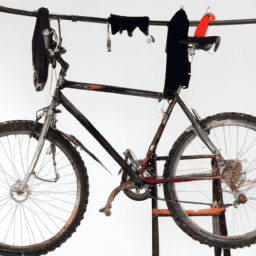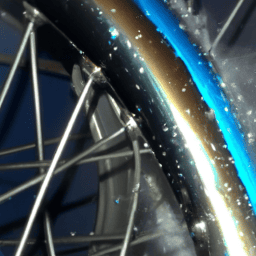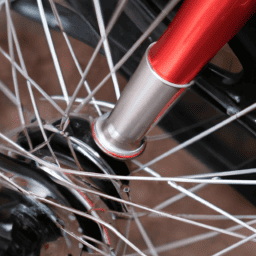As a passionate bike rider, I understand the significance of maintaining your bicycle, particularly through the winter season. The chilly temperatures, along with snow and ice, can wreak havoc on your bike if it isn’t stored correctly. This is why I’m eager to offer my advice and strategies for properly storing a bicycle during the winter months.
First and foremost, it’s essential to clean your bike thoroughly before storing it. This will help prevent any rust or corrosion from forming on the metal parts of your bicycle. You’ll want to give your bike a good scrub with soap and water, making sure to get into all the nooks and crannies.
Once your bike is clean, it’s time to choose the right storage location. Whether you’re storing your bike in a garage, shed, or basement, there are certain things to keep in mind to ensure your bike stays safe and protected all winter long.
Key Takeaways
- Cleaning the bike thoroughly before storing it to prevent rust and corrosion.
- Providing a climate-controlled and secure storage location for the bike.
- Protecting the bike from potential damage with a waterproof cover, removing the battery, and lubricating moving parts.
- Regularly checking on the bike during winter hibernation, inspecting tires, brake pads, cables, chain, and metal parts to catch issues early on before they become bigger problems.
Clean Your Bike Thoroughly
Before storing your bike for winter, it’s crucial to give it a thorough cleaning to remove any dirt, grime, and debris that could cause damage or corrosion during storage. To start, gather all the necessary cleaning supplies such as a bike cleaner, degreaser, brushes, and rags.
Begin by spraying the bike cleaner onto the frame, wheels, and other parts of the bike. Use a brush to scrub any stubborn dirt or grime, paying extra attention to chain and sprockets which can accumulate a lot of debris.
After cleaning, rinse the bike thoroughly with water, being careful not to spray water directly onto the bearings or any electronic components. Once rinsed, use a clean rag to dry the bike off completely, making sure to remove any excess water from hard-to-reach areas.
Additionally, it’s important to follow proper drying techniques such as avoiding direct sunlight or heat sources which can cause damage to the bike’s components. With a clean and dry bike, you can move onto choosing the right storage location to ensure your bike stays in top condition throughout the winter months.
Choose the Right Storage Location
Choosing the perfect spot to keep your trusty two-wheeler during the off-season can make all the difference in how well it rides come springtime.
The ideal storage location for your bike should provide climate control, which means it should be dry and free from extreme temperature changes that could cause damage to your bike. A temperature-controlled garage or a basement would be an excellent choice. If you don’t have access to a temperature-controlled space, consider using a bike cover to protect your bike from moisture and extreme temperatures.
In addition to climate control, you should also consider security measures when choosing the right storage location for your bike. A bike rack or a stand can help keep your bike upright and secure, while a lock can prevent it from being stolen. If you’re storing your bike in a public space, make sure it’s not in the way of foot traffic or parked cars.
With the right storage location, your bike will be protected from damage and theft, and it will be ready to ride when the weather improves. To protect your bike from damage further, there are a few more steps you should take.
Protect Your Bike from Damage
I want to share some key points on how to protect your bike from damage during the winter months.
First, covering your bike with a waterproof cover will prevent moisture from getting on the frame and components.
Second, removing the battery from your electric bike and storing it in a dry, warm place will help extend its lifespan.
Finally, lubricating moving parts with a bike-specific lubricant will prevent rust and ensure smooth operation when you’re ready to ride again in the spring.
Covering Your Bike
To keep my bike protected from the harsh winter weather, I always cover it with a waterproof and breathable bike cover. Not only does this provide protection from rain, snow, and wind, but it also prevents dust and other debris from accumulating on the bike. There are many benefits to covering your bike, including extending the life of the components and reducing the need for costly repairs.
When choosing a bike cover, it is important to consider the different types available. The table below outlines some of the most common types of covers and their features. It is important to choose a cover that fits your bike properly and is made from durable materials to provide the best protection.
| Type of Cover | Features |
|---|---|
| Basic | Lightweight, affordable, not suitable for extreme weather |
| Heavy-duty | Thicker material, suitable for all weather conditions, more expensive |
| Indoor | Lightweight, breathable material, protects from dust and scratches |
| Outdoor | Waterproof and UV resistant, suitable for all weather conditions |
| Custom-fit | Made to fit specific bike models, provides maximum protection |
Now that we have covered the benefits of covering your bike and the different types of covers available, let’s move on to the next step of preparing your bike for winter – removing the battery.
Removing the Battery
Powering down your bike by pulling the battery is a prudent precaution to prevent potential problems during the winter months. Proper battery maintenance is essential to ensure the longevity of your bike’s battery.
To start, you should clean and inspect the battery for any signs of damage or corrosion. If you notice any visible damage, it’s best to replace the battery before storing your bike for the winter.
Once you have cleaned and inspected the battery, it’s time to remove it from the bike. Make sure to disconnect the battery’s negative terminal first to prevent any accidental electrical shocks. Store the battery in a cool and dry place away from any sources of heat or direct sunlight.
Following these winter battery storage tips will help ensure that your bike’s battery remains in good condition for many riding seasons to come. With that said, it’s time to move on to the next step of preparing your bike for winter: lubricating the moving parts.
Lubricating Moving Parts
Properly lubricating the moving parts of your bike is crucial for maintaining its performance and preventing wear and tear over time. To begin, you should apply grease to key areas such as the chain, derailleur, and pedals. This will help to reduce friction and keep these parts moving smoothly. Be sure to wipe away any excess grease to prevent dirt and debris from accumulating.
In addition to applying grease, it’s important to take steps to prevent rust from forming on your bike. You can do this by applying a rust prevention spray to any metal parts that are exposed to the elements. This will help to protect them from moisture and other environmental factors that can cause rust.
By properly lubricating and protecting your bike’s moving parts, you can help to ensure that it stays in good condition throughout the winter months. It’s also important to periodically check on your bike to make sure that everything is still running smoothly.
Check on Your Bike Periodically
Hey, you don’t want your bike to feel neglected, so make sure to give it some love by checking on it every once in a while during its winter hibernation. Regular maintenance is key to keeping your bike in great shape, especially during the off-season.
It’s important to create a winter storage checklist that includes checking on your bike periodically. During your periodic check-ins, make sure to inspect the tires for any signs of deflation or cracking. Check that the brake pads and cables are still in good condition and not rusted. Ensure that the chain is still lubricated and move it around to prevent it from settling in one place. Also, check for any signs of rust or corrosion on the metal parts and wipe them down if necessary.
By regularly checking on your bike, you can catch any issues early on and address them before they become bigger problems. When spring rolls around, your bike will be ready to go with minimal effort.
Preparing Your Bike for Spring
Now that I’ve checked on my bike periodically throughout the winter, it’s time to start thinking about preparing it for spring. Spring maintenance is crucial for ensuring that my bike is in top shape for the upcoming riding season.
One of the most important things I can do is to give my bike a tune-up. To perform a bike tune-up, I’ll need to inspect all of the components of my bike to make sure nothing is damaged or worn out. Here are the steps I’ll follow:
- Check the tires: I’ll make sure they’re properly inflated and don’t have any punctures or tears.
- Check the brakes: I’ll test the brakes to make sure they’re working correctly and adjust them if necessary.
- Check the chain: I’ll lubricate the chain and check for any signs of wear or damage.
- Check the gears: I’ll test the gears to make sure they’re shifting smoothly and adjust them if necessary.
- Check the cables: I’ll make sure the cables are properly adjusted and lubricated.
- Check the pedals: I’ll make sure the pedals are securely attached and rotate smoothly.
By performing a bike tune-up, I can ensure that my bike is in top shape and ready for the upcoming riding season.
Frequently Asked Questions
Should I remove the tires before storing my bike for winter?
Yes, it’s recommended to remove the tires before storing your bike for winter. This will allow for proper tire maintenance and prevent flat spots. It also makes tire replacement easier if needed.
Can I store my bike outside in a covered area?
I wouldn’t recommend storing your bike outside in a covered area during winter. The bike is still exposed to the elements, which can cause damage. It’s best to store it indoors or in a climate-controlled environment to protect it.
How often should I check on my bike during the winter storage period?
I check my bike every two weeks during winter storage to ensure it stays in good condition. Winter bike maintenance includes checking tire pressure, lubricating the chain, and inspecting the brakes. Follow these winter bike storage tips for a smooth ride come spring.
Is it necessary to cover my bike with a tarp or bike cover?
Covering a bike with a tarp or bike cover has pros and cons. The cover provides protection from dust, moisture, and UV rays. However, it can trap moisture and lead to rusting. Alternatives include storing indoors or using a breathable cover.
Should I lubricate the chain before storing my bike for winter?
Yes, it’s important to lubricate the chain before storing your bike for winter. Using a high-quality lubricant like WD-40 or Finish Line will help protect against rust and corrosion. Apply it evenly and wipe off any excess.
Conclusion
In conclusion, storing your bicycle properly during the winter months is essential for maintaining its longevity and performance. By following the steps outlined in this article, you can ensure that your bike is protected from damage and ready to ride when spring arrives.
Did you know that, according to a study conducted by the League of American Bicyclists, nearly 40% of all bicycle accidents occur during the winter months? This statistic paints a vivid picture of the potential risks involved in riding a bike during the colder season.
By taking the time to properly store your bike, you can avoid the dangers of winter riding while also ensuring that your bike is in top shape for the spring. Remember, a little preparation now can go a long way in ensuring a safe and enjoyable biking experience later on.
















